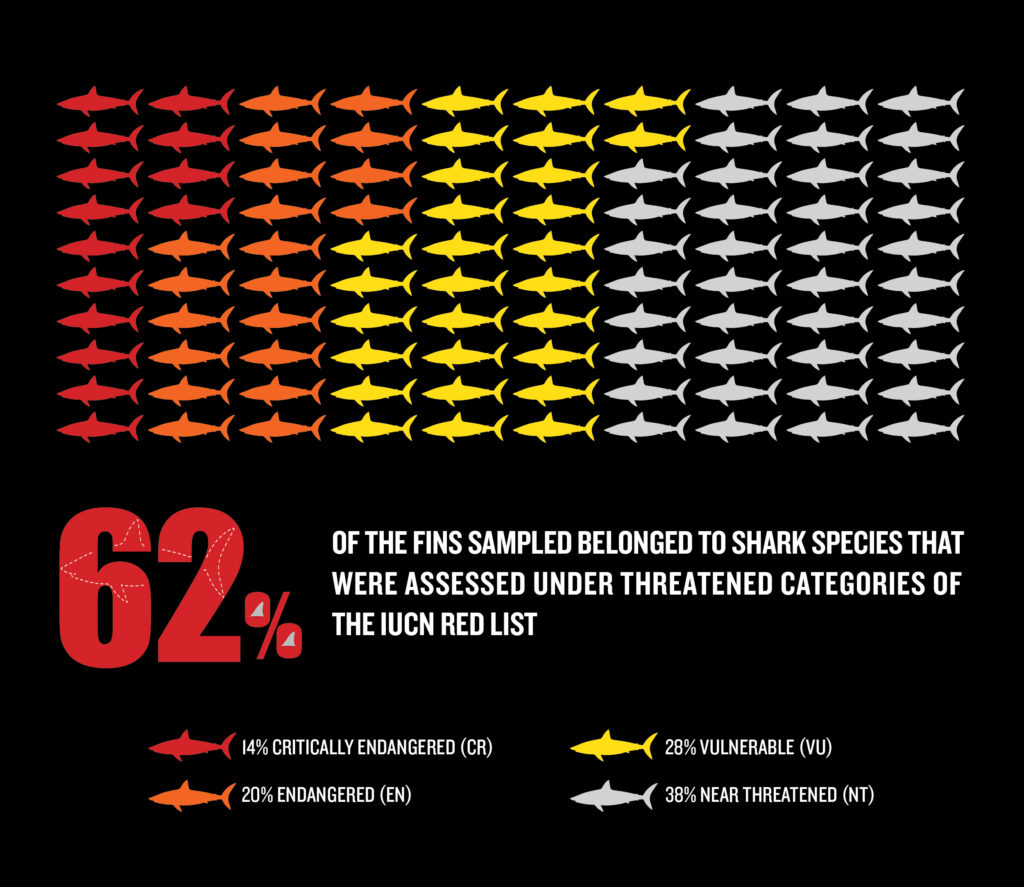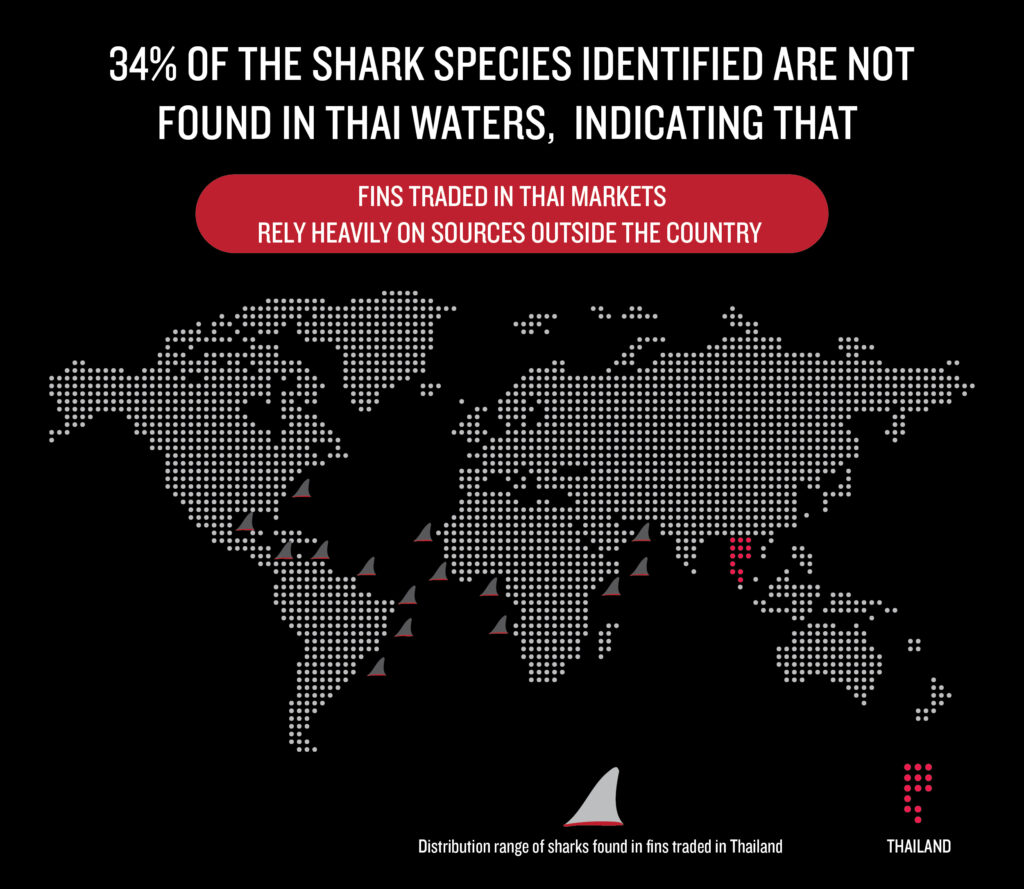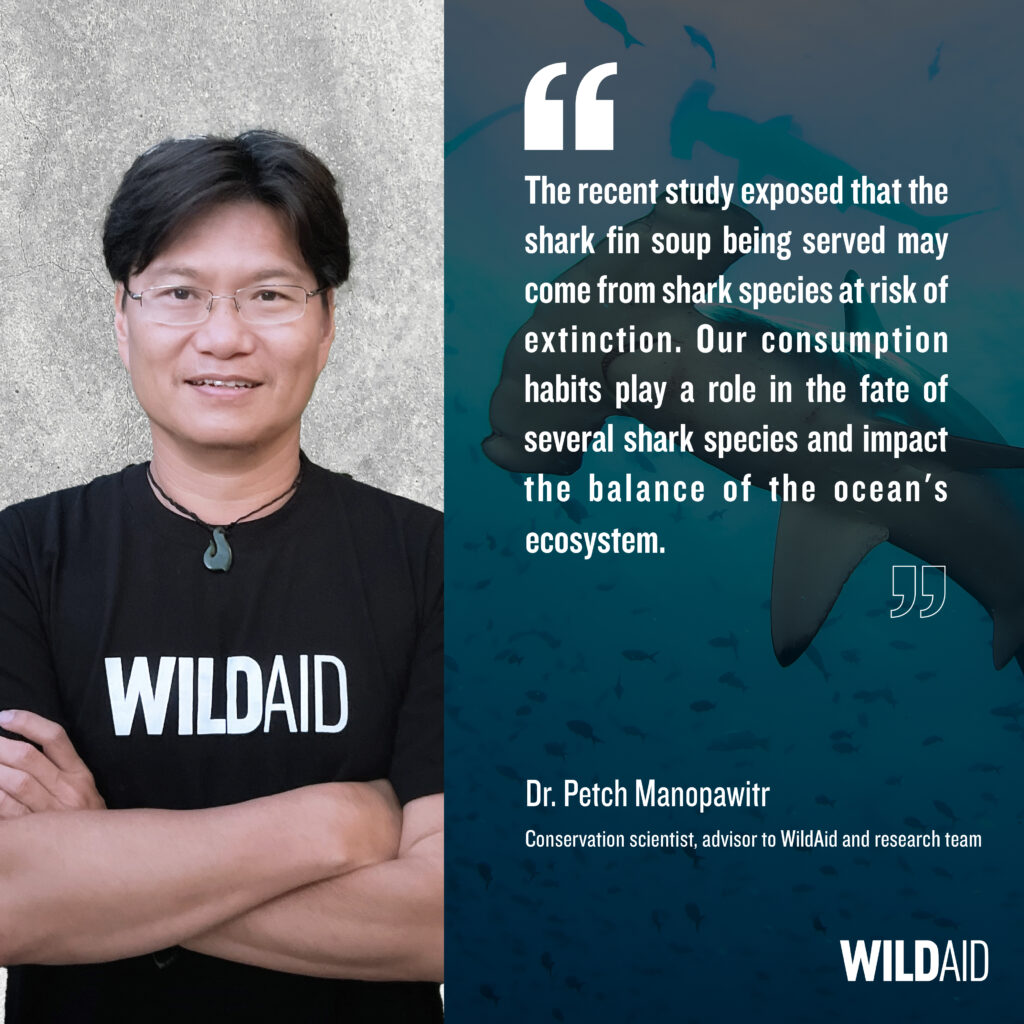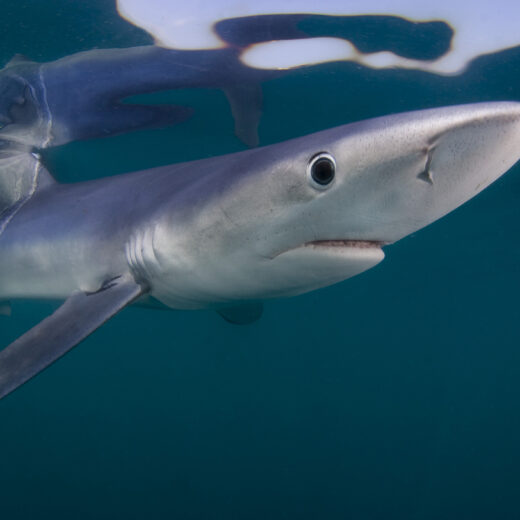
Bangkok, December 20, 2023 – WildAid, together with a team of researchers including those from Thailand’s King Mongkut’s Institute of Technology Ladkrabang (KMITL) and the country’s Department of Fisheries, unveiled alarming findings from a DNA analysis study of shark fin products sold in Thailand.
The report revealed that a shocking 62% of the fins sampled came from shark species that are at risk of extinction according to the IUCN Red List. The study also found a significant prevalence of small-sized fins, indicating the concerning potential exploitation of juvenile sharks in the trade. In a forthcoming WildAid survey, a notable decrease in the demand for shark fin over the last six years has been documented. However, there is still a persistently high level of interest among Thais who intend to consume shark fin in the future. These findings indicate that Thailand remains an active market for shark fin consumption. WildAid’s work helps to highlight the urgent need for shark conservation efforts and urges the public to say no to shark fin.


This is the first time DNA analysis has been used to identify shark species from shark fin products in Thailand. Detailed findings were published in the Conservation Genetics journal. Using advanced molecular biology techniques, the study identified a minimum of 15 unique shark species from the 206 fin samples collected with support from Thailand’s Department of Fisheries. Species identified included three species considered “Critically Endangered” (CR) by the IUCN Red List, four species listed as “Endangered” (EN), and six considered “Vulnerable” (VU).
“The discovery of sharks with Vulnerable to Critically Endangered status highlights the urgent need to protect these species. Many threatened species were identified through small fins, which demonstrates that further research is needed to confirm the presence of juvenile sharks. Young sharks play a crucial role in the recovery of shark populations, and finding them within the trade is concerning,” said Dr. Wanlada Klangnurak, lead researcher and lecturer at the Department of Animal Production Technology and Fishery, Faculty of Agricultural Technology, King Mongkut’s Institute of Technology Ladkrabang.
Thirty-four percent of the identifiable fins were from sharks that have never been recorded in Thai waters, indicating that the fins traded in Thai markets rely heavily on sources outside the country and may be imported to satisfy local demand and/or for re-export. The study also highlighted the vulnerability of juvenile sharks, as many of the samples from identifiable species listed as Critically Endangered (CR), Endangered (EN), and Vulnerable (VU) were from small-sized fins. Globally, one-third of all shark and ray species are at risk of extinction as a result of overfishing and bycatch.


The study reaffirms that fins traded for consumption within the country may come from shark species that are at risk of extinction. Two species of hammerhead sharks, the scalloped hammerhead (Sphyrna lewini) and great hammerhead (Sphyrna mokarran), found in this study are categorized as Critically Endangered (CR) in both the IUCN Red List and Thailand Red Data, according to the country’s Office of Natural Resources and Environmental Policy and Planning (ONEP), and are globally regulated by a CITES Appendix II listing. The Thai government is currently working on listing these two hammerhead species as [nationally] protected species under the Wild Animal Conservation and Protection Act (WARPA).
“Sharks are integral to maintaining the delicate balance of the ocean’s ecosystem. The Department of Fisheries acknowledges the crucial role of sharks and is tasked with the development and implementation of the National Plan of Actions for Conservation and Management of Sharks (NPOA-Sharks). Working alongside stakeholders from all sectors, the plan will improve conservation efforts and help in monitoring import-export of shark fin and products made from sharks. The department is committed to implementing measures that effectively monitor and regulate the trade of shark species listed under CITES, ensuring the sustainable use of sharks,” said Chalermchai Suwannarak, Director General, Thailand’s Department of Fisheries.


Also conducted this year, WildAid’s consumer survey, independently carried out by Rapid Asia, found that the number of urban Thais who consumed shark fin in the past 12 months dropped by 27.5% compared to 2017, when our campaign first launched. Remarkably, there has been a 47% decrease in the number of those who consume shark fin 2-5 times per year. Using current population statistics, the survey indicates that the overall number of people who have consumed shark fin in the past 12 months has declined by an estimated 1.3 million people (from 6.6 million consumers in 2017 to 5.3 million people in 2023). Since many of those consumers eat shark fin on more than one occasion throughout the year, this decline represents a huge number of sharks saved–specifically, those that would have otherwise ended up in an estimated 8.2 million servings of soup. The findings suggest that demand reduction campaigns are having an impact, and continued efforts are likely to contribute to a further reduction in consumption. Such work is urgently needed, as 56% of urban Thais still plan to consume shark fin in the future, a confirmation that Thailand remains an active market for shark fin consumption. The full survey report will be released in February.
“WildAid’s survey shows that a significant number of urban Thais still consider shark fin consumption normal. To put it in perspective, it is no different from us consuming tigers or even tiger cubs, which is another species crucial to maintaining the balance of the ecosystem. Our consumption habits play a role in the fate of several shark species and impact the balance of the ocean’s ecosystem. We can all take the first step by saying no to shark fin,” said Dr. Petch Manopawitr, a conservation scientist and advisor to WildAid.
Building upon the findings of this study, WildAid will continue to raise awareness of the impacts of consuming sharks, orchestrate behavioral change around such consumption, and work collaboratively to drive the implementation of the National Plan of Actions for Conservation and Management of Sharks (NPOA-Sharks). WildAid aims to end consumption of sharks, giving their populations around the world a chance to rebound and thrive.
Download the full report here.
-###-
Additional Key Findings:
- The spottail shark (Carcharhinus sorrah) was found to be the most prevalent shark species in the samples collected. This species is listed as Near Threatened (NT) on the IUCN Red List and Vulnerable (VU) to extinction in Thai waters, according to Thailand Red Data List.
- 80% of the species found from the study will be listed in the CITES Appendix II, effective November 2023, while Thailand has requested a reservation on the inclusion of requiem sharks (Carcharhinidae) valid for a period of six years or until November 2028.
- WildAid’s 2023 online survey of 1,007 urban Thais, independently carried out by Rapid Asia, found 21% of respondents, or around 5.3 million people, based on population statistics, have consumed shark fin in the past 12 months, a decline from 29% or around 6.6 million consumers in 2017. 56% of respondents plan to consume shark fin in the future, a slight decline from 61% in 2017.
- Shark fin is most often consumed with family at restaurants (60%), followed by weddings (57%), and with friends at restaurants (46%). This result was consistent with that of 2017.
For media inquiries, please contact:
Meaghan Brosnan, brosnan@wildaid.org, 415-834-3174
Nuthatai Chotechuang, nuthatai@wildaid.org
About WildAid
WildAid inspires change and empowers the world to protect wildlife and vital habitats from critical threats including illegal wildlife trafficking, climate change, and illegal fishing. WildAid delivers impact at scale in two distinct ways: 1) creating innovative communications campaigns that inspire millions of people in China, South East Asia, Africa, and the U.S. to protect endangered wildlife and reduce climate impacts, and 2) strengthening effective ocean enforcement of priority marine areas including marine protected areas, coastal fisheries, coral reefs, and blue carbon habitats with government, NGO, and community partners in 16 countries around the globe. More information on WildAid can be found at www.wildaid.org or follow us on social media: Facebook, X/Twitter, Instagram, LinkedIn.
Stay in touch and get the latest WildAid updates.
SIGN UP


